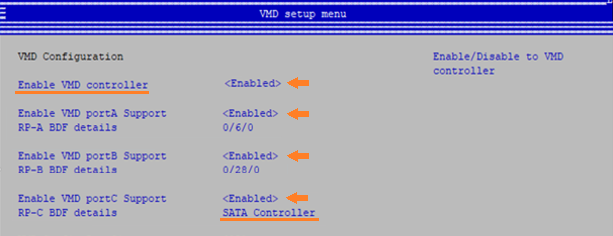The Intel® Rapid Storage Technology (Intel® RST) driver version 18.0 and later support Intel® Volume Management Device (Intel® VMD) technology capable platforms. Intel® VMD is the new way to configure 11th Generation and greater Intel® Core™ Processor-based platforms for Intel® RST management of RAID and Intel® Optane™ memory volumes.
The steps below are required to set up and configure supported systems BIOS for Intel® RST storage management through Intel® VMD.
| What should you know before start? |
- It is not recommended to make changes to the BIOS or RAID/Intel® Optane™ memory volumes without consulting the system vendor. This guide is only a reference for system vendors and expert users.
- The Intel RST driver does not support Linux. Supported operating systems (OS) are only Windows® 10 64-bit and Windows 11* 64-bit.
- This guide describes the steps required to configure a system with no OS. Changes to the BIOS described should not be made after the OS has been installed as this will result in an Inaccessible Boot Device blue screen.
- Platforms that are noted as Intel® Optane™ Memory Ready on a sticker or vendor site do not necessarily mean they support Intel® VMD or the proper BIOS described in this guide.
|
Click or the topic for details:
Step 1: Get the installation drivers
- Download the proper Intel® RST driver (SetupRST.exe file) from Download Center. The proper driver to download depends on the device that is being managed. Check the system specs from the vendor if it is unclear what device is in the platform.
- Open the terminal in the directory with the SetupRST.exe file by right-clicking the directory and selecting Open in Terminal or Open PowerShell here. You may have to press the SHIFT key when right-clicking the directory to see the right option to select.
- Extract the pre-installation drivers by running the command ./SetupRST.exe -extractdrivers SetupRST_extracted
- Copy all driver files from the directory SetupRST-extracted to a USB key media. The file iaStorVD.sys that will be used later on is located here.
Step 2: Enable the Intel® VMD controller in BIOS
- Enter the BIOS.
- Locate the VMD Setup Menu for the platform. Available settings and location in the menu can vary. Refer to the system manual or vendor's support site for specific information for the platform being used. Image below is for reference purposes only.
- Enable the VMD controller.
- Enable the available storage ports that contain the devices to be managed by the Intel® RST driver.
- Select SATA Controller to enable this to be managed by the Intel® VMD controller.
- Save the changes and exit. Intel® RST functionality requires a UEFI OS installation. The Boot Option setting should be UEFI before proceeding. The Legacy Boot Option will result in failures once the OS is installed with the Intel® RST software.

Step 3: Install the Windows* OS
- Start the Windows OS installation process.
- Insert the USB key media where the driver files were copied. Refer to Step 1 if the USB key media does not have the driver files copied.
- During the OS installation process, click Load Driver. The VMD driver will need to be installed to detect the drives being managed by Intel® RST under the Intel® VMD Controller.
- Browse to the location of the iaStorVD.sys file. This file should be under ../Drivers/VMD/ within the driver files copied in the USB key media.
- Select the file iaStorVD.sys.
- Select the drive for the OS installation.
- Complete the OS installation process.
Step 4: Install the Intel® RST driver in the OS
- Once the system boots into the OS, install the SetupRST.exe file downloaded in Step 1. This will install the Windows driver and give the opportunity to download the Intel® Optane™ Memory and Storage Management application from the Microsoft Store* for management of RAID/Intel® Optane™ memory volumes.
| Important considerations |
- The Intel® RST VMD driver should not be uninstalled/removed after installation. This could result in an Inaccessible Boot Device blue screen and potential data loss.
- The VMD device is always enabled on a platform where VMD device is deployed. There is a possible configuration where VMD does not own any device. This is an empty VMD configuration. As a result of this, the Intel® RST VMD driver should always be installed on such a platform to avoid a yellow bang device in Window’s Device Manager.
|
